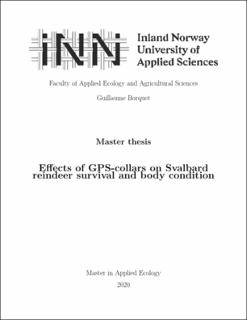Effects of GPS-collars on Svalbard reindeer survival and body condition
Master thesis
Permanent lenke
https://hdl.handle.net/11250/2660538Utgivelsesdato
2020Metadata
Vis full innførselSamlinger
Sammendrag
Modern wildlife and conservation research often relies on GPS collars and on the assumption that collared animals are representative of the study population, but this assumption is rarely tested in the wild. These collars may directly or indirectly affect the animals. Negative effects may include neck wounds, increased locomotion cost and metabolic rate, reduced survival, and others, raising questions about ethics and the representativeness of collared individuals for their populations. Due to the difficulties of incorporating directly-observed control groups into these studies, there is a lack of research regarding these effects. We chose the Svalbard reindeer population from Reindalen–Semmeldalen–Colesdalen valley system to investigate the potential effects of wearing a GPS collar because numerous individuals have been recaptured each year in April since 1994, and censused in August to obtain individual status. Some individuals wear light plastic collars for identification and some are GPS collared,allowing for a control group and evaluation of the effects of the weight of the GPS collar. Additionally, Svalbard reindeer have no natural predators and mortality is mostly caused by starvation or old age, reducing confounding causes of death and complexity of estimating a potential effect of the GPS collar on survival. In this study we test whether wearing a GPS collar has an impact on individual Svalbard reindeer’ survival probability and body condition at the end of winter. We studied survival via mark recapture analysis and body condition by comparing GPS collared (N=48) and individuals with light plastic collars (N=771) female individuals’ back fat thickness. We found that survival and fat thickness were influenced by episodes of rain on snow, age, and their interaction, but not by the presence of a GPS collar. While there was a slight tendency for lower survival when wearing a GPS collar, this effect was non-significant (0.52, CrI: -1.35 - 0.47). We confirm that the maximum 2% body weight to collar weight ratio recommendation was sufficient to avoid detectable negative effects in this population, but the negative trend indicates a possibility that this ratio is close to the tolerable limit for Svalbard reindeer. Although lacking statistical significance, this observed trend highlights the potential effect GPS collars may have on studied populations. To address data quality and animal welfare concerns, possible effects of GPS collars on studied populations should be tested when possible.
